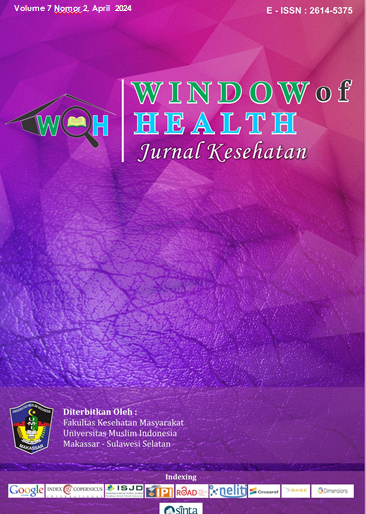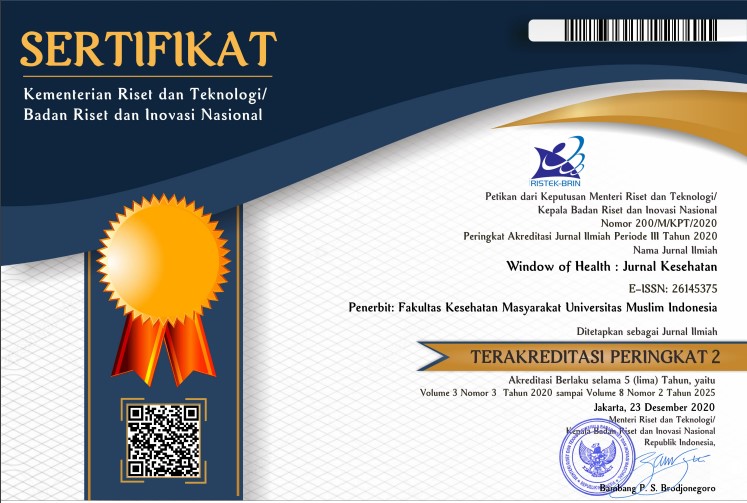Machine Learning Approach to Predict the Dengue Cases Based on Climate Factors
Abstract
Dengue is a global health issue threatening public health, particularly in developing countries. Effective disease surveillance is critical to anticipate impending outbreaks and implement appropriate control responses. However, delays in dengue case reporting are frequent due to human resource shortfalls. Improved outbreak predictive capacity also requires additional input on vector presence and abundance, which is currently not captured in the surveillance platform. Thus, we developed a prototype AI application, “Dengue Forecasting", that leverages machine learning methods in filing the dengue case report and incorporates dengue vector and climatic parameters. This application simplifies the recording of dengue cases, vector abundance (Angka Bebas Jentik/ABJ), and selected climatic variables (sun exposure, temperature, humidity, wind speed, and precipitation) in Bandung City. The relevant data were extracted from Indonesia’s Ministry of Health and the Meteorological, Climatological, and Geophysical Agency. The entire process, from developing the model to deployment, was conducted under R programming language version 4.2.2 using packages (caret, shiny.io). The linear regression model demonstrated the highest precision (RMSE= 268.32 and MAE= 164.1) in predicting the dengue cases and outbreaks. We also applied this to the application deployment. “Dengue Forecasting” has the potential to assist policymakers at the district level, complementing Dengue EWARS, in anticipating and mitigating dengue outbreaks, especially in Bandung City.
References
World Health Organization. Integrating neglected tropical diseases into global health and development: fourth WHO report on neglected tropical diseases [Internet]. Geneva: World Health Organization; 2017 [cited 2024 Mar 6]. 278 p. Available from: https://iris.who.int/handle/10665/255011
Bhatt S, Gething PW, Brady OJ, Messina JP, Farlow AW, Moyes CL, et al. The global distribution and burden of dengue. Nature. 2013 Apr;496(7446):504–7.
WHO. Dengue - Global situation [Internet]. World Health Organization; 2023. Available from: https://www.who.int/emergencies/disease-outbreak-news/item/2023-DON498#:~:text=Weakness%20in%20the%20surveillance%20systems%20in%20many%20affected,transmission%20and%20the%20upsurge%20of%20cases%20and%20deaths.
Kementerian Kesehatan Republik Indonesia. Membuka Lembaran Baru: Laporan Tahunan 2022 Demam Berdarah Dengue [Internet]. Kementerian Kesehatan Republik Indonesia; [cited 2024 Mar 6]. Available from: https://p2p.kemkes.go.id/wp-content/uploads/2023/06/FINAL_6072023_Layout_DBD-1.pdf
Dinas Kesehatan Kota Bandung. Profil kesehatan Kota Bandung tahun 2022 [Internet]. Dinas Kesehatan Kota Bandung; 2023 [cited 2024 Mar 6]. Available from: https://dinkes.bandung.go.id/download/profil-kesehatan-2022/
Deen JL, Harris E, Wills B, Balmaseda A, Hammond SN, Rocha C, et al. The WHO dengue classification and case definitions: time for a reassessment. The Lancet. 2006 Jul;368(9530):170–3.
Vanlerberghe V, Toledo ME, Rodriguez M, Gomez D, Baly A, Benitez JR, et al. Community involvement in dengue vector control: cluster randomised trial. BMJ. 2009 Jun 9;338(jun09 1):b1959–b1959.
Lam SK. Challenges in reducing dengue burden; diagnostics, control measures and vaccines. Expert Review of Vaccines. 2013 Sep;12(9):995–1010.
Turelli M, Hoffmann AA. Rapid spread of an inherited incompatibility factor in California Drosophila. Nature. 1991 Oct;353(6343):440–2.
Hoffmann AA, Montgomery BL, Popovici J, Iturbe-Ormaetxe I, Johnson PH, Muzzi F, et al. Successful establishment of Wolbachia in Aedes populations to suppress dengue transmission. Nature. 2011 Aug;476(7361):454–7.
Walker T, Johnson PH, Moreira LA, Iturbe-Ormaetxe I, Frentiu FD, McMeniman CJ, et al. The wMel Wolbachia strain blocks dengue and invades caged Aedes aegypti populations. Nature. 2011 Aug;476(7361):450–3.
FKKMK. FKKMK-UGM. 2016. Demam Berdarah Dengue: Tantangan Indonesia. Available from: https://fkkmk.ugm.ac.id/demam-berdarah-tantangan-indonesia/
Haryanto B. Indonesia Dengue Fever: Status, Vulnerability, and Challenges. In: J. Rodriguez-Morales A, editor. Current Topics in Tropical Emerging Diseases and Travel Medicine [Internet]. IntechOpen; 2018 [cited 2024 Feb 14]. Available from: https://www.intechopen.com/books/current-topics-in-tropical-emerging-diseases-and-travel-medicine/indonesia-dengue-fever-status-vulnerability-and-challenges
Utama IMS, Lukman N, Sukmawati DD, Alisjahbana B, Alam A, Murniati D, et al. Dengue viral infection in Indonesia: Epidemiology, diagnostic challenges, and mutations from an observational cohort study. Messer WB, editor. PLoS Negl Trop Dis. 2019 Oct 21;13(10):e0007785.
Tsheten T, Gray DJ, Clements ACA, Wangdi K. Epidemiology and challenges of dengue surveillance in the WHO South-East Asia Region. Transactions of The Royal Society of Tropical Medicine and Hygiene. 2021 Jun 2;115(6):583–99.
Ghaffar Nia N, Kaplanoglu E, Nasab A. Evaluation of artificial intelligence techniques in disease diagnosis and prediction. Discov Artif Intell. 2023 Jan 30;3(1):5.
Ramudu K, Mohan VM, Jyothirmai D, Prasad DVSSSV, Agrawal R, Boopathi S. Machine Learning and Artificial Intelligence in Disease Prediction: Applications, Challenges, Limitations, Case Studies, and Future Directions. In: Karthick GS, Karupusamy S, editors. Advances in Healthcare Information Systems and Administration [Internet]. IGI Global; 2023 [cited 2024 Feb 14]. p. 297–318. Available from: https://services.igi-global.com/resolvedoi/resolve.aspx?doi=10.4018/978-1-6684-8913-0.ch013
Habehh H, Gohel S. Machine Learning in Healthcare. CG. 2021 Dec 16;22(4):291–300.
Chai T, Draxler RR. Root mean square error (RMSE) or mean absolute error (MAE)? – Arguments against avoiding RMSE in the literature. Geosci Model Dev. 2014 Jun 30;7(3):1247–50.
Kuhn M. Building Predictive Models in R Using the caret Package. J Stat Soft [Internet]. 2008 [cited 2024 Mar 7];28(5). Available from: http://www.jstatsoft.org/v28/i05/
Hoyos W, Aguilar J, Toro M. Dengue models based on machine learning techniques: A systematic literature review. Artificial Intelligence in Medicine. 2021 Sep;119:102157.
Kakarla SG, Kondeti PK, Vavilala HP, Boddeda GSB, Mopuri R, Kumaraswamy S, et al. Weather integrated multiple machine learning models for prediction of dengue prevalence in India. Int J Biometeorol. 2023 Feb;67(2):285–97.
Ong SQ, Isawasan P, Ngesom AMM, Shahar H, Lasim AM, Nair G. Predicting dengue transmission rates by comparing different machine learning models with vector indices and meteorological data. Sci Rep. 2023 Nov 5;13(1):19129.
Guo P, Zhang Q, Chen Y, Xiao J, He J, Zhang Y, et al. An ensemble forecast model of dengue in Guangzhou, China using climate and social media surveillance data. Science of The Total Environment. 2019 Jan;647:752–62.
Murillo A, B ÁS. Predicting the incidence of dengue in Costa Rica using a decision tree model based on climatic and socioeconomic variables. In: 2021 IEEE V Jornadas Costarricenses de Investigación en Computación e Informática (JoCICI) [Internet]. San José, Costa Rica: IEEE; 2021 [cited 2024 Mar 6]. p. 1–5. Available from: https://ieeexplore.ieee.org/document/9794345/
Tanawi IN, Vito V, Sarwinda D, Tasman H, Hertono GF. Support Vector Regression for Predicting the Number of Dengue Incidents in DKI Jakarta. Procedia Computer Science. 2021;179:747–53.
Zhao N, Charland K, Carabali M, Nsoesie EO, Maheu-Giroux M, Rees E, et al. Machine learning and dengue forecasting: Comparing random forests and artificial neural networks for predicting dengue burden at national and sub-national scales in Colombia. Choisy M, editor. PLoS Negl Trop Dis. 2020 Sep 24;14(9):e0008056.
Fang L, Hu W, Pan G. Meteorological factors cannot be ignored in machine learning-based methods for predicting dengue, a systematic review. Int J Biometeorol. 2024 Mar;68(3):401–10.
Leung XY, Islam RM, Adhami M, Ilic D, McDonald L, Palawaththa S, et al. A systematic review of dengue outbreak prediction models: Current scenario and future directions. Poonawala H, editor. PLoS Negl Trop Dis. 2023 Feb 13;17(2):e0010631.
Abdullah NAMH, Dom NC, Salleh SA, Salim H, Precha N. The association between dengue case and climate: A systematic review and meta-analysis. One Health. 2022 Dec;15:100452.
Brady OJ, Johansson MA, Guerra CA, Bhatt S, Golding N, Pigott DM, et al. Modelling adult Aedes aegypti and Aedes albopictus survival at different temperatures in laboratory and field settings. Parasites Vectors. 2013 Dec;6(1):351.
Messina JP, Brady OJ, Golding N, Kraemer MUG, Wint GRW, Ray SE, et al. The current and future global distribution and population at risk of dengue. Nat Microbiol. 2019 Jun 10;4(9):1508–15.
Cheong Y, Burkart K, Leitão P, Lakes T. Assessing Weather Effects on Dengue Disease in Malaysia. IJERPH. 2013 Nov 26;10(12):6319–34.
Gui H, Gwee S, Koh J, Pang J. Weather Factors Associated with Reduced Risk of Dengue Transmission in an Urbanized Tropical City. IJERPH. 2021 Dec 29;19(1):339.
WHO. Global Vector Control response 2017-2030. World Health Organization; 2017.
Chang FS, Tseng YT, Hsu PS, Chen CD, Lian IB, Chao DY. Re-assess Vector Indices Threshold as an Early Warning Tool for Predicting Dengue Epidemic in a Dengue Non-endemic Country. Scarpino SV, editor. PLoS Negl Trop Dis. 2015 Sep 14;9(9):e0004043.
Garjito TA, Hidajat MC, Kinansi RR, Setyaningsih R, Anggraeni YM, Mujiyanto, et al. Stegomyia Indices and Risk of Dengue Transmission: A Lack of Correlation. Front Public Health. 2020 Jul 24;8:328.
Suryanegara FDA, Suparmi S, Setyaningrum N. The Description of Larva Free Index as COMBI (Communication for Behavioral Impact) Dengue Hemorrhagic Fever Prevention Indicator. Kemas. 2018 Apr 2;13(3):338–44.
Nurmayanti D, Mukarromah HN, Marlik M, La Ane R. Geographic Distribution of DHF Cases and Larvae Free Index In Situbondo Regency, 2019-2021. MKMI. 2023 Mar 31;19(1):9–18.
Sukesi TW, Astuti CT. HUBUNGAN ANGKA BEBAS JENTIK (ABJ) DENGAN INSIDENCE RATE DEMAM BERDARAH DENGUE (DBD) DI TINGKAT KABUPATEN SLEMAN TAHUN 2013-2017. Jurnal Kesehatan dan Pengelolaan Lingkungan. 2020 Jul 1;1(2):57–63.
Sasmita HI, Neoh KB, Yusmalinar S, Anggraeni T, Chang NT, Bong LJ, et al. Ovitrap surveillance of dengue vector mosquitoes in Bandung City, West Java Province, Indonesia. Ramos AN, editor. PLoS Negl Trop Dis. 2021 Oct 28;15(10):e0009896.
WHO. Control of Neglected Tropical Diseases. n.d.
Sari SYI, Adelwin Y, Rinawan FR. Land Use Changes and Cluster Identification of Dengue Hemorrhagic Fever Cases in Bandung, Indonesia. TropicalMed. 2020 May 2;5(2):70.
Churakov M, Villabona-Arenas CJ, Kraemer MUG, Salje H, Cauchemez S. Spatio-temporal dynamics of dengue in Brazil: Seasonal travelling waves and determinants of regional synchrony. Althouse B, editor. PLoS Negl Trop Dis. 2019 Apr 22;13(4):e0007012.
Faridah L, Mindra IGN, Putra RE, Fauziah N, Agustian D, Natalia YA, et al. Spatial and temporal analysis of hospitalized dengue patients in Bandung: demographics and risk. Trop Med Health. 2021 Dec;49(1):44.
Phanitchat T, Zhao B, Haque U, Pientong C, Ekalaksananan T, Aromseree S, et al. Spatial and temporal patterns of dengue incidence in northeastern Thailand 2006–2016. BMC Infect Dis. 2019 Dec;19(1):743.
Copyright (c) 2024 Muhammad Nasir, Shobiechah Aldillah Wulandhari, Dhihram Tenrisau, Muhammad Haris Ibrahim, Ajeng Rahastri, Nilna Sa’adatar Rohmah, Asik Surya, Burhanuddin Thohir, Desfalina Aryani, Muhammad Firdaus Kasim

This work is licensed under a Creative Commons Attribution-NonCommercial-ShareAlike 4.0 International License.








